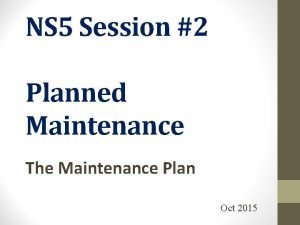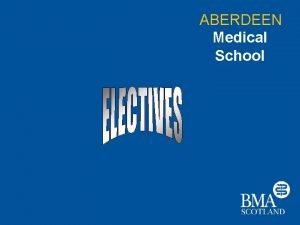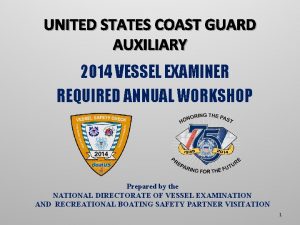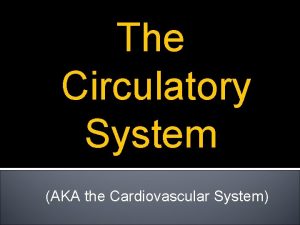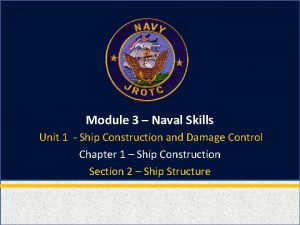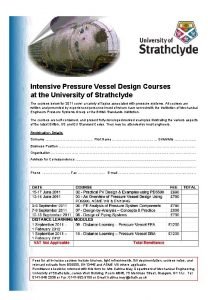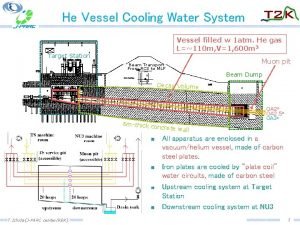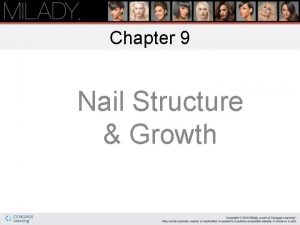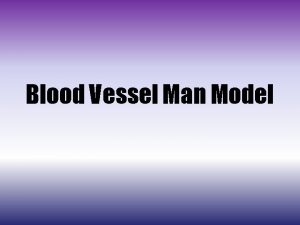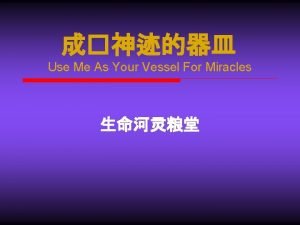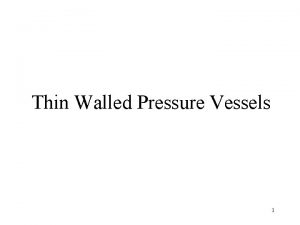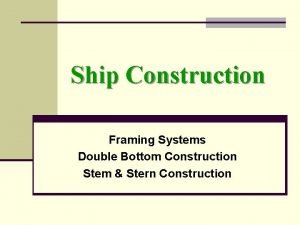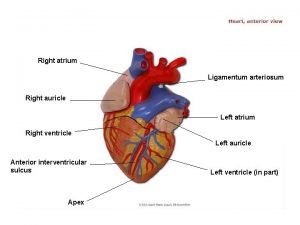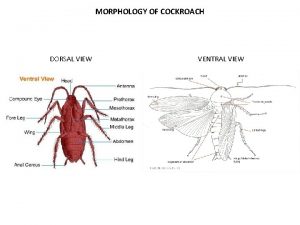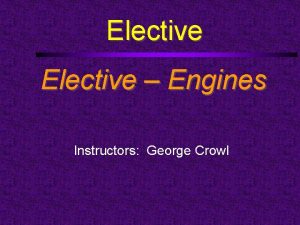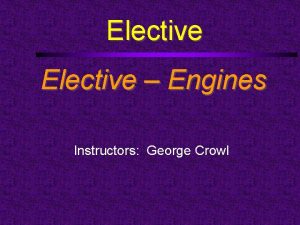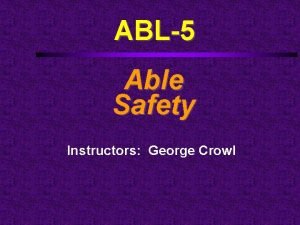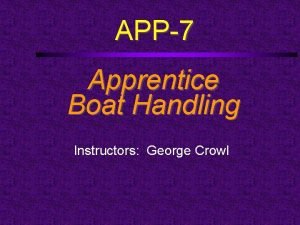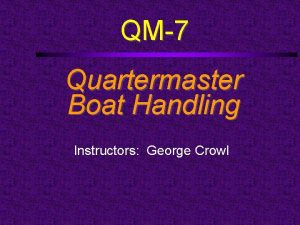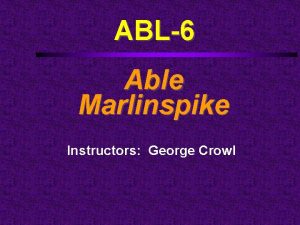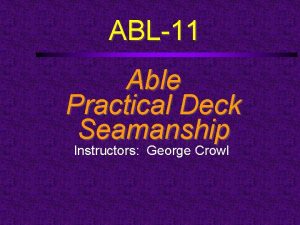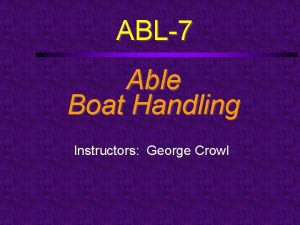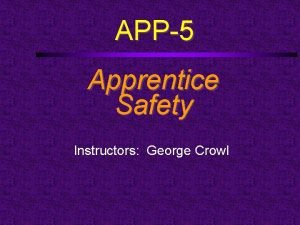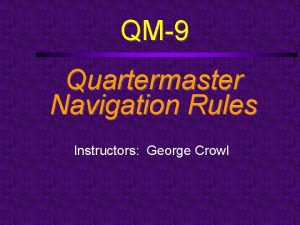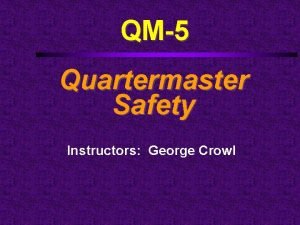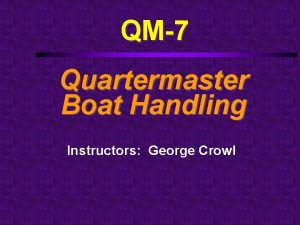Elective Vessel Maintenance Instructors George Crowl Elective Level









































- Slides: 41

Elective – Vessel Maintenance Instructors: George Crowl

Elective Level 3 (Quartermaster) Overhaul Instructors: George Crowl

Lesson Plans / PPTs Needed We need someone to prepare lesson plans and/or PPTs for the following lessons in this series v Fiberglass repair v Paddlecraft construction v Building a paddlecraft v Rigging

Course Outline 3. Take charge of reconditioning or overhauling at least one of your ship's vessels, or take charge of hauling out the principal vessel used by your ship. In either case, lay out a plan of the work to be done in advance, including an estimate of the materials, tools, cost, and time involved.

What Size is the Task? Fiberglass repair to some Sunfish? Hauling out a nominal 30 -foot sloop? Major interior renovation? What is within the Scout's capabilities? Is it a reasonable amount of work?

Prepare the Plan May be a difficult part Identify likely problems Predict needed materials Check on tool availability. Rent? Buy? How many man-hours or man-days will it take? What skills are needed? Does the ship have them? Do you need to hire them? Cost breakdown and total? Accuracy?

Schedule the Work Do first steps first Determine appropriate work party size Schedule the right skills at the right time Schedule things like paint drying time and curing time

Determine Who is in Charge The Scout may not have the expertise or time to be in charge of all the tasks Should certain tasks be delegated? Who is responsible for various sets of tasks? Should you seek a consultant to help?

After-Action Report Scout should keep notes on things that go well and poorly Scout should conduct “roses & thorns” or “start/stop/continue” session Recommend prepare a written after-action report for future reference

Questions?

Elective Level 3 (Quartermaster) Electricity Instructors: George Crowl

Course Outline Electricity: i) Know and demonstrate the correct method of rescuing a person in contact with a live wire. ii) Understand the construction of simple battery cells. Demonstrate the proper care of storage batteries. iii) Explain the difference between direct current and alternating current and the best uses for each. iv) Demonstrate that you know how to replace fuses, reset circuit breakers, and properly splice shipboard electric cable. v) Submit a diagram of the electrical system aboard the vessel used by your ship. vi) Explain wire tables, the current-carrying capacity of circuits, and the hazards and prevention of electrical overloading. vii) Explain electrolysis as applied to the deterioration of a boat’s underwater fittings by galvanic action and its prevention.

Electricity Level 3 i) i) Know and demonstrate the correct method of rescuing a person in contact with a live wire.

Rescuing a Person DO NOT TOUCH THEM! You will get the same shock they have, and be disabled Call 911. They will likely guide you. Cut off the power at circuit breaker If a line is down, DO NOT TOUCH Call power company, ask them to cut power

Still in Contact with Live Wire Stay 100 ft away from downed high wires! Do not attempt rescue. Household current – probably will not paralyze Find wood or plastic pole (non-conducting) Dry rope is also non-conducting Pull wire free of person, or person from wire

After Freed from Contact Move away from danger Call 911 if not already done Lay person on back Check breathing and heartbeat Start rescue breathing or CPR if needed Treat for shock, cover above and below Treat 1 st/2 nd burns with cold water, no oil / grease Bad 3 rd burns – cut away clothing, sterile

Electricity Level 3 ii) Understand the construction of simple battery cells. Demonstrate the proper care of storage batteries. [Type a below] [Types of storage batteries a. Flooded cell battery (deep cycle) b. Sealed cell battery c. Gel battery d. Absorbed glass mat (AGM)]

Battery Construction Lead-acid battery. Ea cell = 2 V, need 6 for 12 V. Dilute sulpheric acid conducts electricity Positive = lead dioxide, negative = pure lead Positive = +, red; negative = -, black

Care of Storage Batteries Clean terminals regularly (baking soda) Insure cells of conventional batteries are full with distilled water Put a “boot” on the positive (red) terminal Light dielectric grease on terminals Insure tied down tight Eliminate wing nuts, they come loose Charge fully, 13 V or more Keep in battery storage box with lid

Electricity Level 3 iii) Explain the difference between direct current and alternating current and the best uses for each.

AC vs. DC Direct Current (DC) flows in one direction at a level voltage (below left), usually from a battery Alternating Current (AC) flows back and forth at varying voltage (below right), usually from an alternator or commercial power source

AC vs. DC (2) Shore power is AC, powers lights, TV, microwave, electrical sockets for tools, etc. Shore power is normally 110 V, 60 Hertz (cycle) Commercial vessels may use selfgenerated AC at 240/480 V to run motors, etc. Most boat power is DC, nav lights, engine and navigation instruments, cabin lights, etc.

AC vs. DC (3) AC is needed to transmit electricity a long way over power lines. High voltage can be transformed down to house-hold 110 V by transformers relatively easily Universally used for household and manufacturing purposes DC is best for many electronic applications DC cannot travel far, so within a black box is OK

Electricity Level 3 iv) Demonstrate that you know how to replace fuses, reset circuit breakers, and properly splice shipboard electric cable.

Replace Fuses Demonstrate, don't talk Fuses may actually be hard to find, check your car fuses if you don't have fuses on your boat Check fuse box list. If you don't have a list, experiment (BUT start the list!) Turn off master switch if possible Remove fuse cover

Replace Fuses (2) Remove (pull out or unscrew) fuse Inspect to see that it is blown (broken) (use mulitmeter) Confirm proper fuse rating (in amps) Install fuse of equal or lower rating, then cover Common ratings – 10 A, 15 A, 30 A If fuse blows quickly, solve the underlying problem first! Then reinstall another fuse. (Use multimeter) Overloaded circuits can lead to fires

Reset Circuit Breakers Look like small light switches Button forced out of alignment Run your hand along to find one “popped” Push to “OFF”, then back “ON” If it pops again, fix the problem, don't keep resetting C/B

Shipboard Cable Splicing Meet ABYC standards (see NOTES for article) Use marine racheting crimp connectors Heat-shrinkable butt connectors (nylon tube) If exposed to water, use and melt heatsensitive adhesive to waterproof the connection

Electricity Level 3 v) v) Submit a diagram of the electrical system aboard the vessel used by your ship.

Electrical System Includes AC and DC Shows batteries, motor, instruments, etc Uses conventional electrical diagram symbols Good starting source should be the motor electrical diagram for your engine Most Sea Scout boats have been modified – show reality, not the way it was built Probably will require you to use a circuit tester to find out what reality is

N L

Electricity Level 3 vi) Explain wire tables, the current-carrying capacity of circuits, and the hazards and prevention of electrical overloading.

Wire Tables Two kinds – AWG and Metric (mostly AWG) Standardizes wire selection Provides conservative general guidance to the public about how much current a wire can carry Design engineers will do a more precise job Sizes #0000 (0. 46”) to #32 (0. 008”), large to small

Typical Wire Table #14 wire Diameter – 0. 0641” Diameter – 1. 62814 mm Ohms/1000' – 2. 525 Ohms/km – 8. 282 Max amps for chassis wiring – 32 Max amps for power xmsn – 5. 9 Max freq – 6700 Hz Breaking strength – 119 pounds

Current-Carrying Capacity Also Current Rating or Ampacity Depends on: insulation temperature rating, conductor resistance, AC frequency, ambient temperature, heat dissipation Insulation is often the driving factor Cables (several wires) have lower capacity because of heat buildup, or conduit Figures are for continuous current, short overloads will not usually affect Circuit breakers are sized to fit capacity

Electrical Overload Hazards Fire and electrical arcing are main issues Overheated wire or arcing wire can start a fire Electrical arc could set off gasoline explosion Multi-meters are useful in detecting overloads

Overload Prevention Size your circuit breakers and/or fuses to the current capacity Loose or corroded wires increase resistance and current. Means more current, possible arcing. Troubleshoot popped circuit breakers Unplug high current appliances (microwave, toaster, waffle iron, etc. )

Electricity Level 3 vii) Explain electrolysis as applied to the deterioration of a boat’s underwater fittings by galvanic action and its prevention.

Electrolysis, Galvanic Action Electrolysis – “Chemical decomposition produced by passing an electrict current through a liquid or solution containing ions. ” Galvanic corrosion – Two different metals will cause corrosion if in contact, or if in water that can pass ions from one metal to the other

Prevention Install one or more zinc sacrificial anodes on the prop shaft and/or other equipment Check your berth for stray electrical currents Check your through-hulls at every quick haul

Questions?
 Ns5 maintenance system
Ns5 maintenance system Alabama boating study guide
Alabama boating study guide Edgar dale’s cone of experience?
Edgar dale’s cone of experience? Generic elective academic writing and composition
Generic elective academic writing and composition Aberdeen electives
Aberdeen electives Simula katawan wakas
Simula katawan wakas Streamü
Streamü Uccsu
Uccsu Elective ict
Elective ict Eogd examen
Eogd examen George washington vs king george iii venn diagram
George washington vs king george iii venn diagram George washington vs king george iii venn diagram
George washington vs king george iii venn diagram Da pam 750-35
Da pam 750-35 Blood vessel adaptations
Blood vessel adaptations Vessel examiner test answers
Vessel examiner test answers Smallest blood vessel
Smallest blood vessel 3 main parts of circulatory system
3 main parts of circulatory system Towing vessel center of expertise
Towing vessel center of expertise Stern landing vessel
Stern landing vessel Internodium neuron
Internodium neuron Navy vessel one feels constricted in
Navy vessel one feels constricted in Cold stretching cryogenic vessel
Cold stretching cryogenic vessel Pressure vessel design course
Pressure vessel design course Vessel cooling
Vessel cooling What is ga plan of ship
What is ga plan of ship Vessel 2012
Vessel 2012 Lima vessel of the heart
Lima vessel of the heart Specialized ligaments attach the nail bed and
Specialized ligaments attach the nail bed and Blood vessel man model
Blood vessel man model Angi vessel
Angi vessel Could 131 g of xenon gas in a vessel
Could 131 g of xenon gas in a vessel Vessel traffico marittimo
Vessel traffico marittimo Use me as your vessel
Use me as your vessel Sea vision vessel
Sea vision vessel Thin walled pressure vessel definition
Thin walled pressure vessel definition Transverse frame ship
Transverse frame ship Psychology
Psychology Identify the highlighted vessel
Identify the highlighted vessel Diagram of the dorsal view of a cockroach
Diagram of the dorsal view of a cockroach Efferent lymphatic vessel
Efferent lymphatic vessel Sinusoidal capillaries
Sinusoidal capillaries On urdu
On urdu
